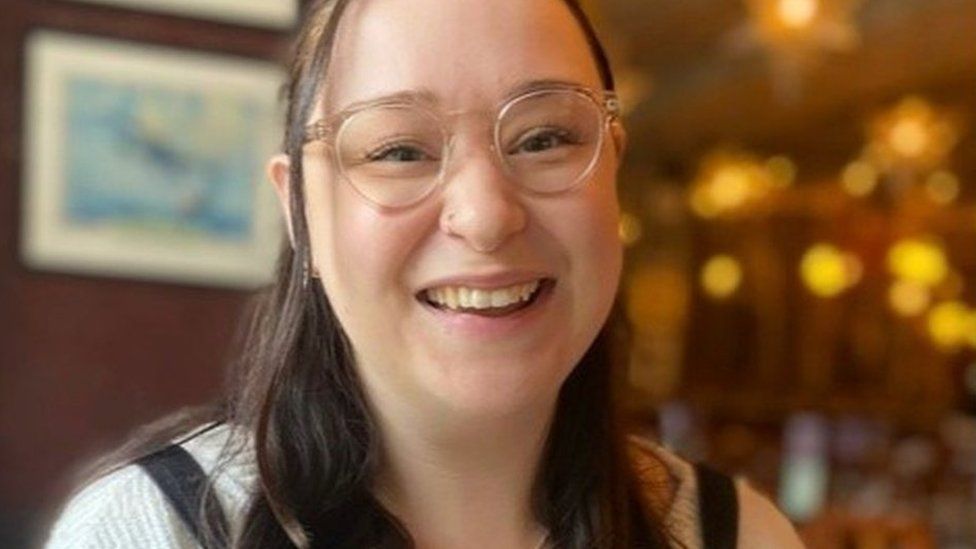
Emma is graduating from medical school this year
By Nick Triggle
Health correspondent
The NHS needs more doctors, and this year saw a record number of applications from medical students to start junior doctor training. But problems behind the scenes have meant many have not yet been found jobs. What has gone wrong?
When the email of congratulations arrived in her inbox last month, Emma could not have been any more excited. Inside was meant to be the details of her first job as a junior doctor.
On the brink of graduation from Warwick Medical School, the 29-year-old was due to find out about where she would working for the next two years.
But despite the email being titled congratulations, next to each of her placements for her two-year foundation course, the first rung on the doctor training ladder, was the abbreviation TBC.
Emma’s email did not confirm where she would be working
She had been given what is called a placeholder job. “I’ve been told I will have a job, but that they don’t know where yet and it could take until three weeks before I am due to start in August for me to find out. All I know is it will be somewhere in the West Midlands South region.
“It is incredibly unsettling. It makes you feel unvalued and an inconvenience. The NHS is short of doctors and yet they cannot find me a job.
“I am renting at the moment, but depending on where I am placed I may have to give notice to my landlord and move.”
Emma was one of more than 1,000 medical students in this position when the emails initially went out. That was nearly one in nine of those who have applied to start junior doctor training this summer.
Since then the numbers have dropped to 800 as NHS trusts have created new roles and some students have already decided not to take up their place.
Part of the problem is that there has been an increase in medical students this summer to start junior doctor training, with just over 9,700 accepted by the UK Foundation Programme, up from 8,655 in 2023.
Some of these will have come from abroad, and under immigration rules the NHS cannot prioritise UK-trained students.
The increase is welcome given the need to train more doctors, with the government in England aiming to double the number of medical student places by 2031.
But it has meant NHS trusts have struggled to keep up and ensure they have enough training posts for new graduates.
‘A lottery’
The British Medical Association has this week written to the health secretary to warn it is “exceedingly concerned” about the placeholder situation, after being inundated with complaints from worried medical students.
Its letter says many are reporting they may only be told where they will be three weeks before their August start date, when work schedules are meant to be confirmed at least eight weeks in advance.
All they know is what part of the UK they are going to be working in after being allocated to one of 18 foundation school areas in March.
Some cover very large areas. There is one each for Wales, Scotland and Northern Ireland, while in England, one covers the whole of Yorkshire and Humber.
Medical students have also had to cope with a change in the way their regions are allocated. As part of the process, they have to list each foundation school in order of preference.
Previously people were allocated according to merit – with each student ranked according to how they had performed during their studies and in an application test.
But this year that has changed and has been done randomly. The logic behind it was that the previous system was stressful for students and was particularly unfair on those from deprived backgrounds and ethnic minorities. They tended to perform less well, and therefore were more likely to be posted to regions they did not favour, according to the UK Foundation Programme.
However, overall it has resulted in more students not ending up with one of their top five choices – more than 730 compared to just over 430 last year.
Image source, Getty Images
BMA medical students committee deputy chairman Rob Tucker says while students understood the logic behind changing the system, he feels “something has gone wrong” given what has happened.
“Students feel like they are in a lottery. It all depends what number the computer algorithm spits out.”
And he is worried it will lead to more people dropping out and not progressing on to the next stage of training.
“Having more students with their bottom choices, and so many with placeholder jobs, increases the chances of more medical students walking away.
“It’s very hard if you end up in a part of the country you don’t want to work [in] and then if you don’t know where you are going to work in that particular region until as little as a few weeks before you start, that’s not fair.
“It costs a lot of money to train a doctor. It’s good value if they work for the NHS for 30 or 40 years, but not if you lose them straight away.”
‘Bottlenecks’
There is sympathy for their plight among those running the system.
Speaking at the Royal College of Physicians annual conference last month, North London Foundation School deputy director Dr Celia Bielawski said the deaneries were working hard with NHS trusts to create the new junior doctor posts needed.
“We have an increasing number of international medical graduates applying for foundation training every year, and the government is very keen that we should take these doctors as we need to train up additional doctors to go up through the ranks.
“At the moment we don’t have places for all of them, but we are all actively working, creating additional posts and I’m confident that they will all be placed.
“We have to get trusts to agree to take them, that’s one of the fundamental issues and bottlenecks with all of this. But we’ll get there, I am sure.”
Prof Sheona Macleod, director of education and training at NHS England, is confident the situation will be resolved too, saying: “We will get there because we’ve committed to finding them a post.”
But she also pointed out that under the previous system, medical students could still find themselves without a job initially as some would be placed on a national reserve list after the first round of job offers.
“We have made sure people know where they are going, as in what region, which is different to the past.”
But she added: “The numbers have meant that the anxiety for the students looking at finding places hasn’t gone away and we’re very aware of it.”
Additional reporting by Catherine Snowdon.



